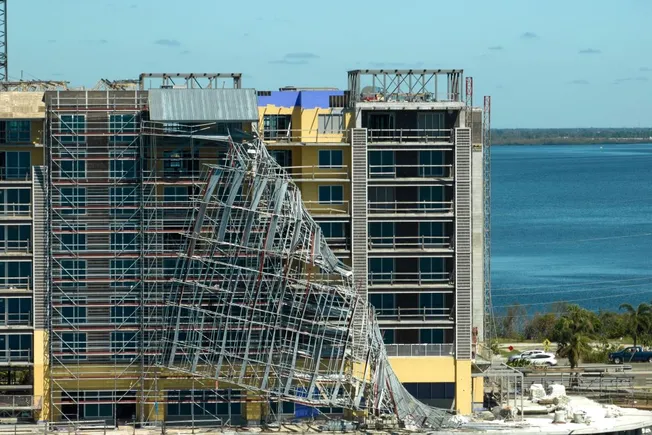Escalating Hurricane Impact on Construction
In recent years, the frequency and intensity of hurricanes in North America have surged dramatically, leading to devastating effects on the construction industry. Major storms such as Hurricane Ida (2021), Hurricane Ian (2022), Hurricane Lee (2023), and Hurricane Helene (2024) have collectively caused billions of dollars in damages and the results of Hurricane Milton are anticipated to be equally devastating, if not worse. These storms have severely disrupted project timelines, strained budgets, and exacerbated supply chain issues. With sustained winds reaching up to 165 mph, coupled with catastrophic flooding, these events exemplify the growing unpredictability of weather patterns, particularly in high-risk regions like the Gulf Coast.
The construction industry, already grappling with tight margins and complex risk management, faces an even greater challenge as climate change accelerates. According to the National Oceanic and Atmospheric Administration (NOAA), the average economic loss from hurricanes in the U.S. has increased significantly, with losses reaching $145 billion in 2021 alone. This climate volatility heightens the need for advanced risk management strategies that go beyond traditional methods.
As a result, insurance brokers are now beginning to play a pivotal role in guiding general contractors on how to effectively mitigate weather-related risks. By leveraging cutting-edge technology and predictive data forecasts, brokers can help contractors anticipate disruptions, adjust timelines, improve project resilience, and stabilize long-term profitability. This whitepaper, produced by American Global in collaboration with EHAB, explores how integrating these technology-driven solutions enables them to help clients in the construction sector take a proactive approach to mitigating and managing weather-related risks.
Weather Impact on Construction Projects and the Importance of Predictive Data
Extreme weather has historically been an inevitable, uncontrollable factor in construction. However, as climate change intensifies, the impact of weather events is becoming more pronounced, particularly in high-risk regions such as the Gulf Coast. According to our research and data from EHAB’s technology solution, projects along the Gulf Coast, including in cities like Miami, New Orleans, and Houston, have seen an average increase of 51.19% in weather delays since 2015. In Miami, this figure rises to a staggering 96.39% for asphalt work, one of the most weather-sensitive activities.
Such delays can severely impact project timelines and budgets. Integrating technology to predict weather patterns helps general contractors anticipate and mitigate these delays. Using predictive weather analytics, utilizing 45 years of historical data to run climate trend analysis, we were able to identify five key insights in locations such as Corpus Christi, New Orleans, Pensacola, and Houston, offering contractors a data-backed view of future weather impacts.
Click here to review the related Case Study on Gulf Coast Projects and Predictive Insights.
Innovative Technology Solutions for Risk Mitigation
In response to the growing risks posed by extreme weather, we wanted to outline some of the leading technology solutions that help mitigate weather impacts and safeguard project timelines. These tools provide a structured, data-driven approach to decision-making that replaces traditional, often speculative, methods.
- ClimaCast: Allows contractors to model how weather patterns will impact their projects up to 2050, using historical data to predict trends in temperature, rainfall, and other weather variables. With this forward-looking capability, contractors can better plan for adverse weather and adjust project timelines accordingly.
- WeatherWise: A detailed schedule analysis tool that identifies the best opportunities for adjustments to avoid weather-related downtime. For example, it could suggest altering the order of work activities based on weather predictions to optimize productivity during the construction window.
- ClimaCover: A parametric insurance product that automatically pays out when planned activities are delayed due to weather. This can protect contractors from incurring losses due to weather-related interruptions, and the automated payout process minimizes delays in receiving compensation.
These solutions provide contractors with a clear view of how changing weather patterns will impact their operations, enabling them to make informed decisions and mitigate risk. In turn, this allows them to plan more accurately, avoid costly delays, and stabilize profitability.
The Role of Parametric Insurance in Long-Term Planning
Parametric insurance is an innovative solution that complements the predictive. It is based on measurable metrics, such as rainfall levels or wind speed, rather than the actual loss experienced. This allows for a faster payout and a more transparent claims process. In construction, parametric insurance can provide quick financial relief to contractors affected by severe weather, allowing projects to stay on track.
By incorporating parametric insurance into their risk management strategies, brokers can help clients not only plan for weather-related delays but also ensure they have the financial protection needed to weather these disruptions without significant impact on their bottom line.
Click here to read more on Integrating Technology and Insurance for Comprehensive Risk Management and Our Recommendations for General Contractors in the complete whitepaper.

